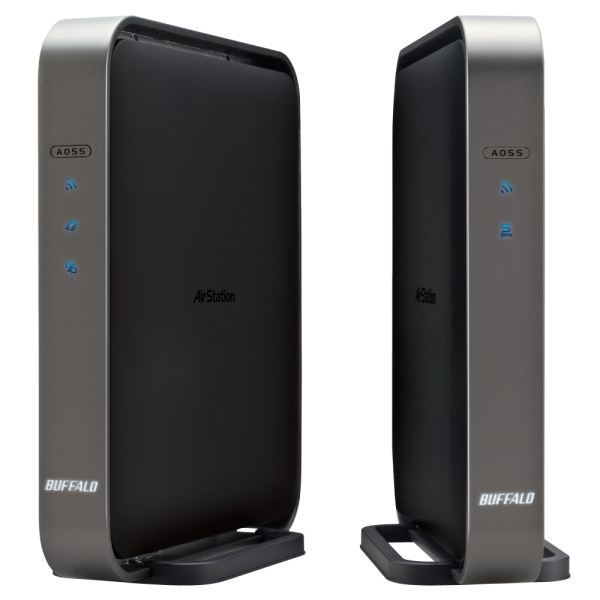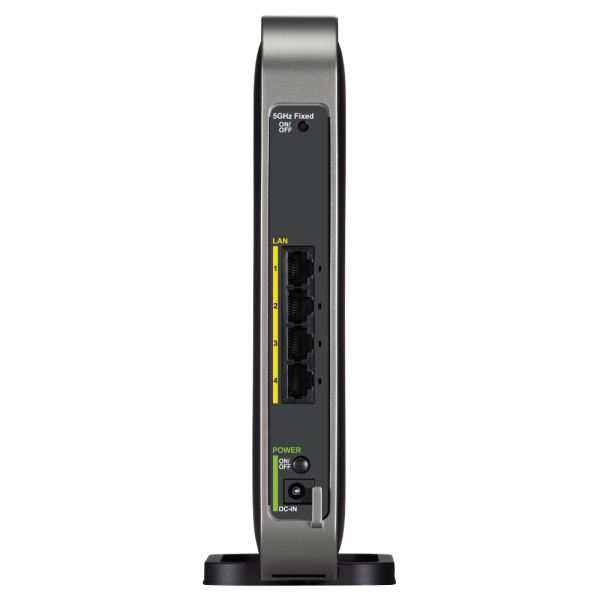Buffalo Technologies Announces Availability of 802.11ac Router and Media Bridge
by Ganesh T S & Brian Klug on May 14, 2012 8:00 AM ESTAt the 2012 CES, we reported on one of the first public 802.11ac technology demonstrations at the Buffalo Technologies booth. Fast forward a few months, and Netgear seemed to have stolen the march on Buffalo Technologies by announcing their R6300 802.11ac model on April 26th. However, Netgear's announcement turned out to be a paper launch. Today, Buffalo Technologies is announcing their first 802.11ac router model and also making it available for purchase right away. Coupled with their 802.11ac media bridge (also launching today), it enables consumers to take advantage of the 802.11ac's Gigabit Wi-Fi capability right away.
AirStation WZR-D1800H Wireless Router
The WZR-D1800H wireless router has 5 GbE ports (1 WAN (Internet access, connected to the modem) + 4 LAN (for the internal network)) and 1 USB 2.0 port with a physical eject button. The industrial design is also improved over the earlier AirStation models, with the sharp edges being replaced by the more pleasing rounded corners.
Internally, the router's 5 GHz band supports 1300 Mbps theoretical throughput with 802.11ac, which is also backward compatible with 802.11n. The 2.4 GHz band is supported with a 3x3 802.11n radio for 450 Mbps of throughput. Simultaneous dual band operation is possible, and so, Buffalo Technologies advertises this as having a total throughput of 1750 Mbps across both the bands. Note that in the pure 802.11n mode, one can get 900 Mbps of total theoretical throughput (450 Mbps in 5 GHz and 450 Mbps in 2.4 GHz).
The absence of any PCs / computing devices with 802.11ac support might turn out to be a bit of a dampener for prospective consumers, but Buffalo Technologies is also introducing a 802.11ac wireless media bridge to enable consumers to take advantage of their 802.11ac router's full capabilities.
WLI-H4-D1300 Wireless Media Bridge
The AirStation AC1300 / N450 is a 4-Port Gigabit Dual Band Wireless Ethernet Bridge intended to extend the capabilities of wireless networks. It makes for an ideal companion to the WZR-D1800H router because of its ability to extend 802.11ac wireless signals to wired devices.
The device has two wireless radios to support 802.11ac and 802.11n in the 5 GHz and 2.4 GHz spectrums. The 802.11n network is dual band (450 Mbps / band), and the wired ports are all Gigabit. We have backward compatibility with 11a, 11b, 11g and 11n.
Buffalo Technologies indicated that both of these products would carry a street price of $179.99. They are available for purchase starting today at Fry's, Frys.com and Newegg.
Source: Buffalo Technologies













11 Comments
View All Comments
gcor - Monday, May 14, 2012 - link
With the wired connection being half the data rate of the air interface, wouldn't USB 3.0 make more sense? Or is the actual throughput of 802.11ac slower than the actual throughput of USB 2.0?lurker22 - Monday, May 14, 2012 - link
I doubt in real world use that it's faster than a wired gig connection. I still use wired for most things because the latency in wireless is so annoying!BuffaloBrian - Monday, May 14, 2012 - link
To be honest, the CPU's used in router products are designed to move IP traffic over RF and Ethernet, there is not a lot of CPU cycles left for NAS functionality. Whether using USB 2.0 or 3.0, the bottleneck will still be CPU so the speed of the port provides no real benefit. In most benchmarks of other companies' products, USB throughout on routers is 10-20 MBps, well under the maximum provided by the USB 2.0 interface.If you want high speed access to disks over your network, a dedicated NAS is required.
Regards,
Brian
PS - I work for Buffalo
hechacker1 - Monday, May 14, 2012 - link
To give an idea of what to expect, my WNDR3700 has a nice 64MB of ram, and a 680MHz atheroes platform.With that, and highly fine tuned (aligned assembly) code, it can barely route around 400-600 Mbits.
At those speeds, the processor is busy with irq storms and unable to schedule traffic with fine enough granularity that it doesn't matter.
To get the full speed, you have to step up to 1GHz+ processors. I think the airports are pretty good in that regard.
tipoo - Monday, May 14, 2012 - link
Does that mean file transfer between PCs wouldn't be that much faster either?sheh - Monday, May 14, 2012 - link
It can go faster. I have a Netgear BCM63281-based router. It reads from USB at 40Mbit over SMB, and close to 50Mbit over FTP.I don't remember the CPU clock right now. It might be 320MHz but I could be wrong.
thetuna - Wednesday, May 16, 2012 - link
10-20 MBps = 80-160 Mbps.Big B for bytes, little b for bits.
LB-ID - Monday, May 14, 2012 - link
The folks at Buffalo are fond of rolling with custom versions of open-source firmware like DD-WRT, which they then fail to update or support via their website. If you can get them on a fire sale, good for you. Otherwise, there are much better options out there.Tetracycloide - Monday, May 14, 2012 - link
Why not just get DD-WRT direct from the source?LB-ID - Tuesday, May 15, 2012 - link
You'd think that would be the solution, but in reality the Buffalo projects are unsupported by the DD-WRT community. Sometimes it's because they tend to use Atheros chipsets (which don't get much community attention at all), and sometimes because there just doesn't seem to be a modding community member willing to champion them.